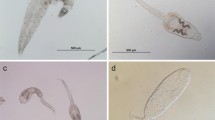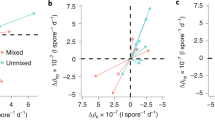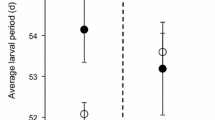Abstract
As disease incidence increases worldwide, there is increased interest in determining the factors controlling parasitism in natural populations. Recently, several studies have suggested a possible role of predation in reducing parasitism, but this idea has received little experimental attention. Here, I present the results of an experiment in which I manipulated predation rate in large field enclosures to test the effects of predation on parasitism using a bluegill predator–Daphnia host–yeast parasite system. Based on previous work showing high bluegill sunfish selectivity for infected over uninfected Daphnia, I anticipated that predators would reduce infection levels. Contrary to expectations, predation did not reduce infection prevalence. Instead, there were large epidemics in all treatments, followed by reductions of host density to very low levels. As Daphnia density decreased, phytoplankton abundance increased and water clarity decreased, suggesting a parasite-driven trophic cascade. Overall, these results suggest that selective predation does not always reduce infection prevalence, and that parasites have the potential to drastically reduce host densities even in the presence of selective predators.



Similar content being viewed by others
References
Anagnostakis SL (1987) Chestnut blight: the classical problem of an introduced pathogen. Mycologia 79:23–37
Anderson RM, May RM (1981) The population dynamics of microparasites and their invertebrate hosts. Philos Trans R S Lond B Biol Sci 291:451–524
Cáceres CE, Hall SR, Duffy MA, Tessier AJ, Helmle C, MacIntyre S (2006) Physical structure of lakes constrains epidemics in Daphnia populations. Ecology 87:1438–1444
Cardinale BJ, Harvey CT, Gross K, Ives AR (2003) Biodiversity and biocontrol: emergent impacts of a multi-enemy assemblage on pest suppression and crop yield in an agroecosystem. Ecol Lett 6:857–865
Carpenter SR, et al (1987) Regulation of lake primary productivity by food web structure. Ecology 68:1863–1876
Chesson J (1983) The estimation and analysis of preference and its relationship to foraging models. Ecology 64:1297–1304
Choisy M, Rohani P (2006) Harvesting can increase severity of wildlife disease epidemics. Proc R Soc Lond Ser B Biol Sci 273:2025–2034
Colfer RG, Rosenheim JA (2001) Predation on immature parasitoids and its impact on aphid suppression. Oecologia 126:292–304
Cottingham KL, Lennon JT, Brown BL (2005) Knowing when to draw the line: designing more informative ecological experiments. Front Ecol Environ 3:145–152
Donnelly CA, et al (2003) Impact of localized badger culling on tuberculosis incidence in British cattle. Nature 426:834–837
Duffy MA (2006) Evolutionary and community ecology of parasitism in Daphnia. Ph.D. Dissertation, Department of Zoology, Michigan State University, East Lansing, MI
Duffy MA, Sivars-Becker L (2007) Rapid evolution and ecological host–parasite dynamics. Ecol Lett 10:44–53
Duffy MA, Hall SR, Tessier AJ, Huebner M (2005) Selective predators and their parasitized prey: are epidemics in zooplankton under top-down control? Limnol Oceanogr 50:412–420
Ebert D (2005) Ecology, epidemiology and evolution of parasitism in Daphnia. National Library of Medicine (US), National Center for Biotechnology Information, Bethesda, MD (available from: http://www.ncbi.nlm.nih.gov/entrez/query.fcgi?DB=Books)
Ebert D, Lipsitch M, Mangin KL (2000) The effect of parasites on host population density and extinction: experimental epidemiology with Daphnia and six microparasites. Am Nat 156:459–477
Ghilarov AM (1985) Dynamics and structure of cladoceran populations under conditions of food limitation. Arch Hydrobiol Beih Ergebn Limnol 21:323–332
González MJ, Tessier AJ (1997) Habitat segregation and interactive effects of multiple predators on a prey assemblage. Freshw Biol 38:179–191
Green J (1974) Parasites and epibionts of Cladocera. Trans Zool Soc Lond 32:417–515
Hall SR, Duffy MA, Cáceres CE (2005a) Selective predation and productivity jointly drive complex behavior in host–parasite systems. Am Nat 165:70–81
Hall SR, Duffy MA, Tessier AJ, Cáceres CE (2005b) Spatial heterogeneity of daphniid parasitism in lakes. Oecologia 143:635–644
Hall SR, Tessier AJ, Duffy MA, Huebner M, Cáceres CE (2006) Warmer does not have to mean sicker: temperature and predators can jointly drive timing of epidemics. Ecology 87:1684–1695
Harvell D (2004) Ecology and evolution of host–pathogen interactions in nature Am Nat 164:S1–S5
Hatcher MJ, Dick JTA, Dunn AM (2006) How parasites affect interactions between competitors and predators Ecol Lett 9:1–19
Hebert DN (1995) The Daphnia of North America: An illustrated fauna. CyberNatural Software, University of Guelph
Hochachka WM, Dhondt AA (2000) Density-dependent decline of host abundance resulting from a new infectious disease. Proc Natl Acad Sci USA 97:5303–5306
Hudson PJ, Dobson AP, Newborn D (1992a) Do parasites make prey vulnerable to predation? Red grouse and parasites. J Anim Ecol 61:681–692
Hudson PJ, Newborn D, Dobson AP (1992b) Regulation and stability of a free-living host–parasite system: Trichostrongylus tenuis in red grouse. I. Monitoring and parasite reduction experiments. J Anim Ecol 61:477–486
Hudson PJ, Dobson AP, Newborn D (1998) Prevention of population cycles by parasite removal. Science 282:2256–2258
Ives AR, Dennis B, Cottingham KL, Carpenter SR (2003) Estimating community stability and ecological interactions from time-series data. Ecol Monogr 73:301–330
Johnson PTJ, Chase JM (2004) Parasites in the food web: linking amphibian malformations and aquatic eutrophication. Ecol Lett 7:521–526
Johnson PTJ, Stanton DE, Preu ER, Forshay KJ, Carpenter SR (2006) Dining on disease: how interactions between parasite infection and environmental conditions affect host predation risk. Ecology 87:1973–1980
Kohler SL, Hoiland WK (2001) Population regulation in an aquatic insect: the role of disease. Ecology 82:2294–2305
Kohler SL, Wiley MJ (1997) Pathogen outbreaks reveal large-scale effects of competition in stream communities. Ecology 78:2164–2176
Lafferty KD (2004) Fishing for lobsters indirectly increases epidemics in sea urchins. Ecol Appl 14:1566–1573
Lafferty KD, Porter JW, Ford SE (2004) Are diseases increasing in the ocean? Ann Rev Ecol Evol Syst 35:31–54
Lafferty KD, Dobson AP, Kuris AM (2006) Parasites dominate food web links. Proc Nat Acad Sci USA 103:11211–11216
Lampert W, Sommer U (1997) Limnoecology: the ecology of lakes and streams. Oxford University Press, New York
Lass S, Spaak P (2003) Chemically induced anti-predator defences in plankton: a review. Hydrobiologia 491:221–239
Lips KR, et al (2006) Emerging infectious disease and the loss of biodiversity in a Neotropical amphibian community. Proc Natl Acad Sci USA 103:3165–3170
Littell RC, Milliken GA, Stroup WW, Wolfinger RD, Schabenberger O (2006) SAS for mixed models, 2nd edn. SAS Institute, Cary, NC
Matsumoto T, Itioka T, Nishida T (2003) Cascading effects of a specialist parasitoid on plant biomass in a Citrus agroecosystem. Ecol Res 18:651–659
Mittelbach GG (2005) Parasites, communities, and ecosystems: conclusions and perspectives. In: Thomas F, Renaud F, Guegan JF (eds) Parasites and ecosystems. Oxford University Press, New York, pp 171–176
Mittelbach GG, Osenberg CW (1993) Stage-structured interactions in bluegill: consequences of adult resource variation. Ecology 74:2381–2394
Mittelbach GG, Garcia EA, Taniguchi Y (2006) Fish reintroductions reveal smooth transitions between lake community states. Ecology 87:312–318
Ostfeld RS, Holt RD (2004) Are predators good for your health? Evaluating evidence for top-down regulation of zoonotic disease reservoirs. Front Ecol Environ 2:13–20
Packer C, Holt RD, Hudson PJ, Lafferty KD, Dobson AP (2003) Keeping the herds healthy and alert: implications of predator control for infectious disease. Ecol Lett 6:797–802
Polis GA, Sears ALW, Huxel GR, Strong DR, Maron J (2000) When is a trophic cascade a trophic cascade? Trends Ecol Evol 15:473–475
Rosenheim JA, Harmon JP (2006) The influence of intraguild predation on the suppression of a shared prey population: an empirical reassessment. In: Brodeur J, Boivin G (eds) Trophic and guild interactions in biological control. Springer, New York, pp 1–20
Snyder WE, Ives AR (2001) Generalist predators disrupt biological control by a specialist parasitoid. Ecology 82:705–716
Snyder WE, Ives AR (2003) Interactions between specialist and generalist natural enemies: parasitoids, predators and pea-aphid biocontrol. Ecology 84:91–107
Stiling P, Moon DC (2005) Quality or quantity: the direct and indirect effects of host plants on herbivores and their natural enemies. Oecologia 142:413–420
Tessier AJ, Woodruff P (2002) Cryptic trophic cascade along a gradient of lake size. Ecology 83:1263–1270
Threlkeld ST (1979) The midsummer dynamics of two Daphnia species in Wintergreen Lake, Michigan. Ecology 60:165–179
Ward JR, Lafferty KD (2004) The elusive baseline of marine disease: are diseases in ocean ecosystems increasing? PLoS Biol 2:542–547
Wetzel RG (2001) Limnology: lake and river ecosystems, 3rd edn. Academic, San Diego, CA
Whiles MR, et al. (2006) The effects of amphibian population declines on the structure and function of Neotropical stream ecosystems. Front Ecol Envir 4:27–34
Acknowledgments
Many thanks to Claes Becker, Carla Cáceres, Erica Garcia, Spencer Hall, Allison Higi, Jarad Mellard, Allison Morgan, Angela Roles, Joe Simonis, Lena Sivars-Becker, Pam Woodruff, and, especially, Darice Shumway and Alan Tessier for help in the field and lab. Angela Roles, Carla Cáceres, Jeff Conner, Tony Ives, Gary Mittelbach, and Alan Tessier all provided helpful feedback on experimental design and/or analysis. Comments from Spencer Hall, Jason Harmon, Tony Ives and two anonymous reviewers greatly improved this manuscript. This work was supported by NSF grant DEB-0508270 (to J.K. Conner and M.A. Duffy), Sigma Xi, and the PEO Sisterhood. I was supported by an NSF Graduate Research Fellowship. This experiment complies with the current laws of the US. This is KBS contribution #1289.
Author information
Authors and Affiliations
Corresponding author
Additional information
Communicated by Craig Osenberg.
Electronic supplementary material
Below is the link to the electronic supplementary material.
Rights and permissions
About this article
Cite this article
Duffy, M.A. Selective predation, parasitism, and trophic cascades in a bluegill–Daphnia–parasite system. Oecologia 153, 453–460 (2007). https://doi.org/10.1007/s00442-007-0742-y
Received:
Accepted:
Published:
Issue Date:
DOI: https://doi.org/10.1007/s00442-007-0742-y




